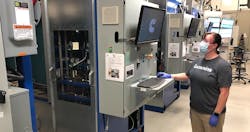Cummins Leader Calls for Government Investments in Low-Carbon and Zero-Emission Technologies
Article by Cummins
Cummins vice chairman Tony Satterthwaite testified before a Senate Committee that advanced internal combustion engines can reduce air pollutants while infrastructure and scale is developing for low-carbon technologies such as battery and fuel cells and electric powertrains.
“The future of power requires multi-faceted innovation,” Satterthwaite told a hearing of the Senate Energy and Natural Resources Committee. Satterthwaite testified virtually because of the pandemic.
Looking towards the future, Cummins has been making a significant investment in battery and fuel cell electric powertrains in recent years, and held its first Hydrogen Day in 2020 to showcase the company’s progress with products using the low-carbon fuel for nearly 2,000 analysts, media members and potential customers.
However, experts say the conversion to low-carbon technologies will take time to develop enough refueling and recharging stations for widespread adoption. Satterthwaite said there are environmental benefits that can be achieved today with existing technologies such as advanced diesel and natural gas engines as the infrastructure develops for low- and no-carbon powertrains.
During the next decade, high efficiency internal combustion engines with mild hybridization and low-carbon fuels can reduce carbon dioxide and criteria pollutants while the country makes progress on climate change as the government ramps up investment to achieve widespread adoption of low- and no-carbon platforms, Satterthwaite said.
He testified that reaching a zero-emission future will require government leadership and commitment from manufacturers. “If the U.S. is to achieve this path to zero in a way that is cost-effective, timely and promotes U.S. jobs and manufacturing, significant public support is needed from the Department of Energy, our national labs and other research institutions to innovate in infrastructure, development and deployment.”
Satterthwaite made a special pitch to the committee for renewable hydrogen during his testimony, maintaining it should be part of the government’s plans moving forward.
“Cummins has invested significantly in the entire hydrogen value chain because it has shown to be one of the most effective enabling technologies for broad and deep de-carbonization of hard-to-abate sectors where Cummins’ products operate,” he said. “Europe and East Asia have an early lead in this space, having committed hundreds of billions of dollars respectively to promote decarbonized hydrogen production and fuel cell equipment deployment.”
